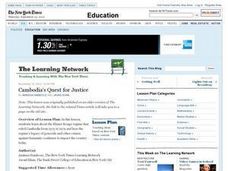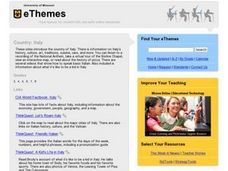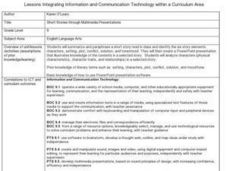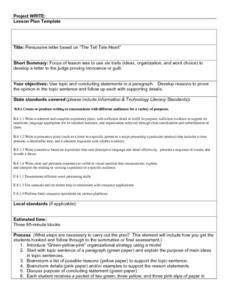Curated OER
The Panorama Of The European Union
Sixth graders investigate the existence of the European Union with the help of a map publication. They also brainstorm to think of terms related to the Union. Students write a summary that should conclude the European Union is a...
Curated OER
Stitching Truth Lesson Two: The Arpilleristas in Pinochet's Chile
Students analyze arpilleras. In this Chilean history instructional activity, students examine social justice issues as they read and interpret arpilleras. Students study the tapestries to learn about Augusto Pinochet and his human rights...
Curated OER
Sum It Up
Students write summaries of books to exemplify comprehension of the stories. They create a story web to outline the important details of the story. In groups, students make story webs for separate chapters for the book. After the webs...
Curated OER
Pay it Forward
Young scholars explore the basic concept of micro-financing. For this economics/literacy lesson, students listen to One Hen by Katie Smith, in which a small loan changes the life of the main character. Young scholars employ comprehension...
Curated OER
It is Our Right-Don't Waste It!
Students explore the basic rights granted to all American citizens by the U.S. Constitution in the light of women's issues. The women's suffrage movement, the role of Susan B. Anthony, and the timeline of events on voting rights are...
Curated OER
Goods for You!
Students define "goods" and "services" and identify examples of both. They read farm books and discuss what we use from animals and plants on a farm. They observe the Wisconsin quarter reverse and locate Wisconsin on a map.
Curated OER
Where's My Dot?
Students explore the five basic elements of Monart, dot, curved line, straightline, and angle line to create a book about their home address. The concept of "big" is explored in this activity.
Curated OER
The Plains Native Americans
Students read The Buffalo Woman by Paul Goble and explore several aspects of Plains Indians cultures. They view historical photos of items from Plains cultures, reference maps and complete worksheets in small groups.
Curated OER
The Alphabet is Historic
Students describe how the Phoenicians, Greeks and Romans passed down the alphabet through the generations. They compare and contrast the letters from early alphabets to the one of today and discuss how they are different. Using a map,...
Curated OER
Tiny Tortillas
Students read the rhyme "Tiny Tortillas" and then explain what the poem is about. They create a list of rhyming words from the poem. They compare and contrast the poem "Tiny Tortillas" with the poem "Patty Cake". They clap out the beat...
Curated OER
Cambodia's Quest for Justice
Students observe pictures, articles, maps, charts and other gathered information concerning the Khmer Rouge regime that ruled Cambodia by participating in a gallery walk. Afterward, they discuss war crimes and the significance of...
Curated OER
Catch Me If You Can: Over and Under
Students read a story. In this vocabulary skills lesson, students read The Gingerbread Man, use flannel cut outs to re-enact the gingerbread man running over and under.
Curated OER
Country: Italy
Students explore Italy. They visit sites about its culture, history, cuisine, art, cars, and traditions. They take a virtual tour of the Sistine Chapel. They read about the history of pizza. They study Italian phrases and pronunciation...
Curated OER
Surprise at Pearl Harbor
Students review the concept of courage and relate it to their daily life. As a class, they are introduced to the events of December 7, 1941 at Pearl Harbor. Using a map, they locate Hawai'i and label the islands. They use the internet to...
Curated OER
Cause and Effect
Students identify cause and effect relationships in a short story. After reading a short story, they participate in a discussion of how one event in a story can lead to several others. Students are then paired for a matching task that...
Curated OER
Short Stories Through Multimedia Presentations
Ninth graders summarize and paraphrase a short story read in class. They identify the six story elements of character, setting, plot, conflict, solution, and tone/mood. Students create a PowePoint presentation that illustrates the...
Curated OER
Favorite Foods
Students explore human health by completing food choice worksheets. In this world hunger lesson plan, students discuss the importance of eating three daily meals and how to feed the underprivileged through charities and soup kitchens....
Curated OER
Historical Figures
Second graders identify a historical figure, his or her societal contributions and basic biography using a Kidspiration graphic organizer and library resources. They use the Internet to conduct an historical treasure hunt in groups.
Curated OER
Country: Austria
Students access a variety of Austria themed websites. They locate information about history, geography, climate, people and culture. They view a live webcam of different parts of Austria and read about famous personalities from Austria.
Curated OER
Los Trenes de Espa¿¿a
Students identify and read correctly the symbols of a Spanish train schedule. Using maps, they identify and locate major cities and landforms of Spain and practice using a twenty-four hour clock. Using the internet, they navigate a...
Curated OER
Persuasive Letters and The Tell Tale Heart
Students write persuasive letters based on "The Tell Tale Heart." They brainstorm topic sentences, main ideas, and details. They analyze the character and determine if he is innocent or guilty. They create a map listing their reasons to...
Curated OER
Aerial Photography
Learners are introduced to a basic property of light and how we use this property in our everyday lives. They understand how this image is inverted because light travels in straight lines.
Curated OER
Where Blues and Jazz Started
In this blues and jazz music worksheet, students read about the origins and basic concepts of blues and jazz music in 2 brief articles. Students then respond to 12 short answer questions regarding the music with its roots in slavery times.
Curated OER
Why Here? Why Not There?
Middle schoolers analyze a map and graph information on eleven countries. Using the characteristics of the countries, they determine if they should host the summer or winter Olympic games. After viewing a video, they locate the...

























